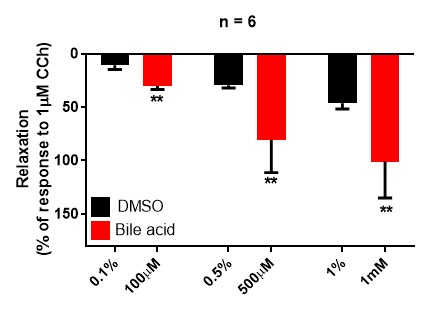Relaxation in Human Lower Esophageal Sphincter
Drug Discovery Assay – reference number: B114
This assay determines whether test articles affect the function of the lower esophageal sphincter (LES) muscle strips precontracted with Carbachol and using Isoprenaline to produce maximum relaxation.
The primary function of the LES is to allow food transit from the esophagus into the stomach. An incompetent LES can lead to Gastroesophageal reflux disease (GERD), increasing the risk for metaplasia and esophageal adenocarcinoma.
| Assay Type: | Gastrointestinal (GI) Tract |
| Tissue: | Human Lower esophageal sphincter |
| Target: | TGR5 receptor |
| Control Compound: | Carbachol/ Isoprenaline |
| Study Type: | Organ bath |
| Functional Endpoint: | Contractile force/ Relaxation |
Testing Information
Introduction
The specific results that will be provided are the effects of increasing concentrations of test articles on the LES.
Test Article Requirements
Test article(s) to be provided by the Sponsor in storable aliquots at required test concentrations with information on diluent vehicle used. Stock solutions are prepared in distilled water unless otherwise requested. Sponsor to provide sufficient test article to run the entire study.
Suggested Testing
Study Outline
Rationale and Experimental Design
The experiment assesses whether test articles cause tonal changes in the lower esophageal sphincter compared with a reference compound.
Exclusion Criteria
No specific exclusion criteria are in place other than to reject macroscopically diseased/necrotic tissue.
Standardization and Qualification
Tissues which do not respond to stimulation by the reference compounds will be excluded.
Lower Esophageal Sphincter Relaxation Assays
Option 1 − IC50 Determination
To assess the ability of each test article to elicit smooth muscle relaxation, 6-point cumulative concentration response curves will be performed for each test article. These concentration response curves (CCRC’s) will be performed following pre-contraction with an appropriate agent, such as Carbachol. A positive control compound and representative test article vehicle CCRC will also be run to allow direct comparison with test articles.
An example of the conditions assessed for 3 test articles are detailed below (each condition will be run in triplicate muscle strips):
Representative test article vehicle CCRC
- Test article 1 CCRC
- Test article 2 CCRC
- Test article 3 CCRC
- Positive control CCRC
Option 2 − pA2 Determination
To assess the ability of a test article to antagonize an agonist mediated relaxation response; 6-point cumulative concentration response curves (CCRC’s) will firstly be performed for the reference agonist, following pre-contraction with an appropriate agent, such as Carbachol. Following a wash out and recovery period, muscle strips will be incubated with the test item (3 different concentrations of test article will be assessed), positive control or test article vehicle before the same 6-point cumulative concentration response curve will be repeated for the reference agonist.
An example of the conditions assessed for 3 test articles are detailed below (each condition will be run in triplicate muscle strips):
- Representative test article vehicle
- Test article 1 concentration 1
- Test article 1 concentration 2
- Test article 1 concentration 3
- Test article 2 concentration 1
- Test article 2 concentration 2
- Test article 2 concentration 3
- Test article 3 concentration 1
- Test article 3 concentration 2
- Test article 3 concentration 3
- Positive control
Supplementary Option
To assess the involvement of a specific receptor subtype in any observed responses, the concentration of test article eliciting the largest response can subsequently (following a wash out and recovery period) be tested in the presence of a specific antagonist. This supplementary option will incur an extra charge.
Analysis
Responses shall be expressed either in milligrams or grams tension, or as a % of the maximal contractile response (e.g. Carbachol) or as % of the maximum relaxation response (e.g. Isoprenaline). Statistical analysis (where appropriate) will be performed using GraphPad Prism, with the results being shown in graphical form in the final report.
Relaxation of LES in response to vehicle and control






![Wire myography: the ultimate guide [protocol included]](https://www.reprocell.com/hs-fs/hubfs/REPROCELL-04.06.18_0163.jpg?width=756&height=425&name=REPROCELL-04.06.18_0163.jpg)